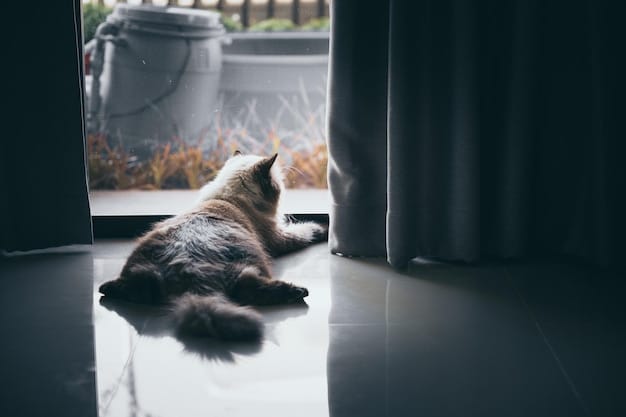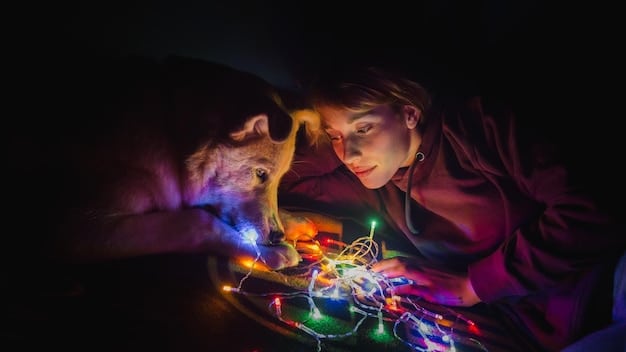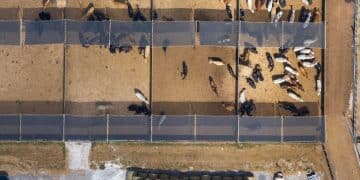Seasonal Affective Disorder in Pets: Manifestations & Management

Seasonal affective disorder (SAD) in domesticated animals can manifest through behavioral changes, altered sleep patterns, and decreased activity levels, often linked to reduced daylight exposure during colder months.
As seasons shift, affecting our moods, it’s natural to wonder: How Does Seasonal Affective Disorder Manifest in Domesticated Animals? This question delves into a nuanced area of animal behavior, exploring whether our beloved companions experience similar shifts in well-being due to changes in light and weather.
Understanding Seasonal Affective Disorder (SAD) in Animals
Seasonal Affective Disorder, commonly known as SAD, is a nuanced condition recognized in humans, characterized by mood changes primarily linked to seasonal shifts, particularly the reduced daylight hours of autumn and winter. The concept of SAD in domesticated animals, while not as extensively documented or diagnostically defined as in humans, presents an intriguing area of study for veterinarians and animal behaviorists.
The core hypothesis for SAD’s manifestation in animals mirrors human understanding: changes in photoperiod (the amount of light received per day) significantly impact an animal’s physiological and behavioral rhythms. This is largely mediated by melatonin, a hormone produced by the pineal gland, which regulates sleep-wake cycles and is influenced by light exposure. When daylight wanes, melatonin production may either increase or decrease, depending on the species and individual, potentially disrupting normal circadian rhythms and neurotransmitter balance.
The Role of Light and Circadian Rhythms
The natural world operates on a cycle of light and darkness, which profoundly influences the biological processes of most living organisms. For domesticated animals, particularly those living indoors, the artificial environment can sometimes buffer these natural rhythms, but it does not entirely eliminate their influence. The intensity and duration of natural light cues the body’s internal clock, or circadian rhythm, which in turn regulates a vast array of physiological functions from hormone secretion to sleep patterns and immune responses.
When light exposure diminishes, the body’s natural response can be a shift in these rhythms. This is not necessarily a pathological condition in all animals, as many species have evolved to adapt to seasonal changes through hibernation or reduced activity. However, in domesticated animals, whose lifestyles are often disconnected from these natural adaptive mechanisms, these light-induced shifts can sometimes lead to behavioral expressions that resemble human SAD.
- Melatonin Production: Reduced light often leads to increased melatonin production, which can induce lethargy and increased sleepiness.
- Neurotransmitter Balance: Serotonin levels, often linked to mood regulation, can be influenced by light, potentially leading to imbalances in some individuals.
- Activity Levels: Natural light encourages physical activity and exploration, while its absence can depress these behaviors.
Moreover, the concept of SAD in pets extends beyond mere physiological responses to light. It encompasses a holistic view of an animal’s environment, including changes in owner routine, decreased outdoor activity due to inclement weather, and a general shift in household dynamics. These external factors can compound the biological responses, creating a complex interplay that contributes to the overall manifestation of seasonal changes in animal behavior.
In essence, understanding SAD in animals requires an appreciation for their deep connection to environmental cues, alongside their unique physiological make-up and the artificial constraints of domestication. The subtle shifts in their behavior during specific seasons warrant attention and empathy from their caregivers, urging us to consider their well-being beyond simply addressing apparent physical ailments.
Recognizing Behavioral Changes in Affected Pets
Pinpointing seasonal affective disorder in pets involves observing a spectrum of behavioral changes that deviate from their normal habits during other times of the year. These manifestations often mirror symptoms seen in humans with SAD, suggesting a common biological underpinning related to light exposure and brain chemistry.
One of the most common indicators is a noticeable decrease in energy and enthusiasm. Dogs may seem less eager for walks or playtime, preferring to nap more frequently. Cats might become less social or engage in fewer interactive behaviors, choosing instead to find isolated, darker spots to rest. This lethargy is more than just a passing mood; it’s a persistent state of reduced activity that lasts for weeks or even months during the darker parts of the year.
Altered Sleep Patterns and Appetite Shifts
Another significant sign of potential SAD in pets is a disruption in their sleep-wake cycle. Animals might start sleeping for longer periods during the day, even becoming difficult to rouse, yet they might also exhibit restlessness at night. This can manifest as pacing, vocalizing, or general unease during hours they would typically be asleep. The quality of their sleep, too, may seem diminished, suggesting an internal struggle with their circadian rhythm.
- Increased Sleeping: Pets may spend significantly more time sleeping, often appearing more fatigued even after rest.
- Nocturnal Restlessness: Paradoxically, some animals might experience disturbed sleep at night, leading to pacing or unwarranted vocalizations.
- Appetite Fluctuations: Changes in appetite, either an increase leading to weight gain or a decrease resulting in reduced food intake, can also be observed.
Beyond sleep, changes in appetite patterns are also commonly reported. Some pets may show an increased desire for food, leading to weight gain, while others may become less interested in their meals. These shifts are not necessarily due to changes in diet or activity alone but seem to be linked to an altered metabolic state that accompanies seasonal changes.
For instance, a usually energetic dog that suddenly becomes withdrawn, sleeps excessively, and shows less interest in food during winter months warrants attention from its owner. Similarly, a cat that typically enjoys daily play sessions but suddenly prefers to hide and appears less responsive to interaction cues could be experiencing seasonal shifts in its mood and energy levels. It’s crucial to distinguish these changes from other health issues, making a veterinary consultation vital.
Observing a persistent cluster of these behavioral changes, especially if they consistently coincide with the same seasonal period each year, is key. Maintaining a behavioral log for your pet can be incredibly helpful in identifying patterns and providing concrete information to your veterinarian. Early recognition allows for timely intervention, potentially improving your pet’s overall quality of life during challenging seasons.
Commonly Affected Species and Individual Susceptibility
While the concept of SAD in animals is still emerging, observations suggest that certain domesticated species and even individual animals within those species may be more prone to experiencing seasonal mood shifts. Dogs and cats, given their close proximity to human lifestyles and the greater likelihood of owners noticing subtle behavioral changes, are the most frequently cited animals in discussions of seasonal affective disorder.
Among dogs, breeds that originated in regions with significant seasonal light variations, or those with highly energetic temperaments, might be more susceptible. For example, some working breeds or those bred for high activity levels may struggle more with enforced inactivity during winter months. Similarly, some cat breeds, particularly those known for their social and interactive nature, may show more pronounced behavioral changes when light levels drop.
Factors Influencing Vulnerability in Pets
Individual variation plays a significant role in how animals respond to seasonal changes. Just as in humans, not every pet will experience noticeable SAD symptoms. Several factors can influence an animal’s vulnerability, including age, overall health, and even prior experiences.
- Age: Older animals, who may be more sensitive to environmental changes or less resilient to stress, might exhibit symptoms more readily.
- Health Status: Pets with underlying health conditions, especially those affecting metabolism or neurology, could be more susceptible.
- Enrichment Levels: Animals with a less enriched indoor environment or those accustomed to extensive outdoor activity may feel the effects more keenly when confined indoors.
- Breed Disposition: Certain breeds with higher energy needs or known sensitivities might show more pronounced signs.
Beyond species and breed, a pet’s daily routine and living environment are critical. Animals that spend a considerable amount of time outdoors during warmer months, or those who benefit from consistent natural light exposure, might experience a more dramatic shift when winter limits these opportunities. Indoor pets, while seemingly less exposed to external changes, can still be affected by reduced natural light coming through windows.

Consider a dog accustomed to long daily walks in a sunny park. When winter arrives, bringing shorter days and bitter cold, forcing a reduction in outdoor time, this dog might become restless, destructive, or lethargic simply due to the unmet need for activity and light. This behavioral shift, while not necessarily a clinical diagnosis of SAD, strongly aligns with the observed manifestations of seasonal influence.
Ultimately, a pet’s individual context, including their genetic predisposition, current health, and the specifics of their living situation, combine to determine their susceptibility to seasonal changes. Owners who are attuned to these factors can better anticipate and respond to their pet’s needs during different times of the year, providing a proactive approach to their well-being.
Differentiating SAD from Other Health Issues
When a pet exhibits changes in behavior or energy levels, it’s natural for owners to worry. While the possibility of seasonal affective disorder exists, it is absolutely critical to first rule out other underlying medical conditions that can present with similar symptoms. Many serious ailments, from hormonal imbalances to chronic pain or neurological issues, can cause lethargy, changes in appetite, or altered sleep patterns.
A thorough veterinary examination is the foundational step in this process. This usually includes a physical check-up, blood tests, and potentially other diagnostic procedures. The vet will assess vital signs, examine organs, and look for any physical signs of illness that could explain the behavioral shifts. Blood work can reveal issues like thyroid dysfunction, anemia, or infections, all of which can mimic SAD symptoms.
The Importance of Veterinary Consultation
Self-diagnosing SAD in a pet can be risky, as it might lead to overlooking a more serious and treatable condition. A veterinarian will consider the seasonality of the symptoms, their duration, and their severity, but only after confirming that no other medical explanation is present. They will also inquire about changes in the pet’s environment, diet, and routine to gather a comprehensive picture.
- Full Medical Check-Up: Essential to rule out physiological causes for behavioral changes.
- Blood Work: Can identify conditions like hypothyroidism or metabolic issues affecting energy and mood.
- Behavioral History: Crucial for the vet to understand the context and patterns of the “sad-like” behaviors.
- Exclusion of Pain: Pets can hide pain, but chronic discomfort can manifest as lethargy or irritability.
For instance, a dog showing increased sleepiness and weight gain might be suffering from hypothyroidism, a common condition that requires specific medication. Similarly, a cat that suddenly becomes withdrawn and less active could be experiencing joint pain or kidney disease. These conditions require veterinary intervention, and delaying diagnosis by assuming SAD could have severe consequences for the pet’s health.
Once medical issues are ruled out, the veterinarian can then work with the owner to explore the possibility of SAD. This collaborative approach ensures that the pet receives appropriate care, whether it’s medical treatment for an illness or environmental/behavioral adjustments for seasonal fluctuations. The goal is always to ensure the pet’s comfort and well-being, prioritizing their health above all else.
A detailed history provided by the owner, noting the onset, duration, and specific nature of the behavioral changes, is invaluable for the veterinarian. It helps them build a timeline and identify patterns that might point towards a seasonal component, guiding them towards a more targeted diagnostic or management plan.
Management Strategies and Environmental Enrichment
Once a veterinarian has ruled out other medical causes and seasonal affective disorder is suspected, there are several management strategies owners can implement to support their pets through the darker months. The primary goal is to counteract the effects of reduced natural light and increase mental and physical stimulation.
The most straightforward approach involves increasing light exposure. This can be achieved by ensuring pets spend more time near windows, especially south-facing ones, or by using artificial light sources. Full-spectrum light bulbs, which mimic natural daylight, can be beneficial. These lights should be used for a consistent period each day, ideally mimicking the natural light cycle during brighter seasons.
Implementing Light Therapy and Increased Activity
Light therapy for pets, while not as standardized as for humans, involves exposing the animal to specific wavelengths and intensities of light. Special “light boxes” designed for humans are sometimes adapted for pets, but professional guidance is recommended to ensure safe and effective use. The duration and intensity of light exposure need to be carefully considered to avoid overstimulation or other adverse effects.
Beyond light, increasing an animal’s physical activity and mental engagement is crucial. Even if outdoor conditions are less inviting, finding ways to encourage exercise indoors or adapting outdoor activities can make a significant difference. Regular, consistent walks, even short ones, can help maintain an animal’s routine and provide exposure to natural light and fresh air.
- Increase Natural Light: Ensure ample access to sunny spots in the home or consider sun lamps.
- Regular Exercise: Maintain consistent activity levels, adapting to indoor play if outdoor conditions are poor.
- Mental Stimulation: Introduce new toys, puzzle feeders, or training sessions to keep the pet engaged.
- Social Interaction: Increase dedicated play time and bonding moments with the owner.
Mental enrichment is equally important. Puzzle toys that dispense treats, interactive games, or even short training sessions can help alleviate boredom and provide a much-needed mental outlet. For cats, introducing new climbing structures, feather wands, or new places to explore can counteract lethargy. These activities not only combat boredom but also help regulate mood by promoting positive associations and reducing stress.

Finally, maintaining consistent routines helps stabilize a pet’s internal clock. Consistent feeding times, regular play sessions, and predictable sleep schedules can provide a sense of security and structure, which is beneficial for animals potentially struggling with seasonal shifts. This holistic approach to management addresses both the physical and psychological aspects of what may be seasonal affective disorder.
It’s important to remember that these strategies are supplementary and should be discussed with a veterinarian. Each pet is unique, and personalized recommendations, potentially including dietary adjustments or even supplements, may be part of a comprehensive management plan aimed at improving their well-being during challenging seasons.
Preventative Measures and Long-Term Well-being
Proactive approaches to pet care can significantly help in mitigating the effects of seasonal changes, potentially preventing the full manifestation of SAD-like symptoms. Prevention often centers on optimizing an animal’s environment and routine, ensuring they receive consistent stimulation and support throughout the year, regardless of the season.
One key preventative measure is to ensure consistent exposure to bright, natural light, even during the shorter, darker days. This doesn’t necessarily mean outdoor time in harsh weather but rather optimizing indoor light conditions. Position pet beds or favorite resting spots near windows where they can benefit from daylight. Consider incorporating full-spectrum lighting indoors, particularly in areas where pets spend most of their time.
Year-Round Behavioral Monitoring and Adaptation
Maintaining a proactive approach involves year-round behavioral monitoring. Owners who are attuned to their pet’s normal demeanor and habits are better positioned to notice subtle changes as seasons shift. Keeping a simple journal of their pet’s energy levels, appetite, and sleep patterns can provide valuable data over time, helping to identify seasonal patterns before they become severe.
- Consistent Light Exposure: Prioritize natural light access and consider supplemental full-spectrum lighting.
- Varied Exercise Routine: Adapt exercise to changing weather, incorporating indoor activities (treadmills, play) when outdoor options are limited.
- Engagement and Enrichment: Continuously introduce new toys, puzzles, and training to prevent boredom year-round.
- Nutritional Support: Ensure a balanced diet and discuss species-appropriate supplements with a vet to support overall health.
Adapting exercise routines for different seasons is also crucial. Instead of completely abandoning daily walks during winter, shorten them or find indoor alternatives like doggy daycare, interactive play sessions, or even indoor agility. For cats, introducing new interactive toys or climbing structures can keep them mentally and physically engaged when outdoor exploration is not possible.
Additionally, ensuring adequate social interaction and mental stimulation throughout the year is vital. Regular playtime, training sessions, and opportunities for bonding with family members can significantly impact a pet’s overall well-being. A mentally stimulated and socially engaged pet is often more resilient to environmental stressors, including seasonal changes.
In essence, long-term well-being and prevention of SAD-like symptoms in pets involve a holistic approach that acknowledges their physiological and psychological needs year-round. By providing a stable, enriching environment and being vigilant about behavioral shifts, owners can significantly contribute to their pet’s sustained happiness and health, ensuring they thrive regardless of the season.
The Future of Understanding Animal SAD
The concept of seasonal affective disorder in domesticated animals is an evolving area of veterinary science and animal behavior. While anecdotal evidence from pet owners is widespread, rigorous scientific research specifically focused on diagnosing and understanding SAD in pets is still in its nascent stages. The future of understanding and managing this condition lies in a multi-faceted approach involving more dedicated research, clearer diagnostic criteria, and greater awareness.
One of the primary challenges is the subjective nature of behavioral observations. What one owner perceives as lethargy, another might simply see as an animal being “lazy.” Standardized behavioral assessments, perhaps using technologies like accelerometers, could provide more objective data on activity levels and sleep patterns. Furthermore, biochemical markers, similar to those studied in humans with SAD, could be explored in animals to identify physiological correlates of seasonal mood changes.
Advancements in Research and Veterinary Practice
Future research will likely focus on several key areas. Understanding the specific neurochemical pathways that are affected by photoperiod changes in different animal species will be critical. This could lead to the development of more targeted interventions, including pharmaceutical or nutritional supplements designed to balance neurotransmitter levels if imbalances are confirmed.
- Objective Data Collection: Utilizing wearables and behavioral monitoring systems for precise activity and sleep tracking.
- Biochemical Markers: Research into hormonal and neurotransmitter changes correlating with seasonal shifts.
- Species-Specific Studies: More focused research across different breeds and species to understand variations in susceptibility.
- Novel Therapies: Development of targeted light therapy protocols or nutritional interventions based on scientific findings.
Moreover, the integration of behavioral science into veterinary practice will become more pronounced. Veterinarians will likely receive more extensive training in animal behavior, enabling them to better identify subtle cues of distress or discomfort that might be linked to seasonal factors. This will help them distinguish SAD from other conditions more efficiently and provide holistic advice to pet owners.
Public awareness campaigns will also play a significant role. As more owners become informed about the potential for SAD in their pets, they will be more likely to seek professional advice and implement preventative measures. This increased awareness could also lead to more data collection from real-world scenarios, which can further inform scientific studies.
Ultimately, the future promises a deeper, more evidence-based understanding of how seasonal changes impact our domesticated companions. This will lead to more effective diagnostic tools, a broader range of therapeutic options, and ultimately, an enhanced quality of life for pets experiencing seasonal challenges. The conversation about animal SAD is just beginning, and its trajectory is one of growing scientific curiosity and compassionate care for our animal family members.
| Key Aspect | Brief Description |
|---|---|
| 🐾 Behavioral Changes | Pets may show decreased energy, reduced interest in play, and increased lethargy during darker months. |
| 😴 Sleep & Appetite Shifts | Disrupted sleep patterns (more daytime sleep, nocturnal restlessness) and changes in eating habits. |
| 👨⚕️ Veterinary Consultation | Crucial to rule out other medical conditions before considering SAD, ensuring proper diagnosis. |
| 💡 Management Strategies | Increasing light exposure, enhancing physical activity, and providing mental stimulation. |
Frequently Asked Questions About SAD in Pets
While SAD is more commonly discussed in dogs and cats due to observation by owners, the scientific evidence for its presence across all domesticated animals is still developing. However, any animal sensitive to light changes could theoretically experience similar symptoms. It’s more of a recognized pattern in smaller pets with close human interaction.
Like in humans, it’s largely attributed to reduced exposure to natural sunlight during autumn and winter. This affects the production of key hormones like melatonin and serotonin, disrupting circadian rhythms and influencing mood, energy levels, and sleep patterns. Indoor environments can further exacerbate a lack of light exposure.
The key is professional veterinary consultation. Symptoms like lethargy, changes in appetite, or altered sleep can indicate various health issues. A vet will perform a thorough examination and tests to rule out medical conditions before considering SAD. Behavioral patterns tied to seasons are also a strong indicator.
Management often involves increasing light exposure through natural sunlight or full-spectrum lamps, enhancing physical activity indoors and outdoors, and providing engaging mental stimulation. Consistency in routine, including feeding and playtimes, can also help stabilize a pet’s mood and well-being during challenging seasons.
Prevention focuses on proactively managing light exposure and maintaining mental and physical enrichment year-round. This includes ensuring access to natural light, varying exercise routines with indoor options for poor weather, and consistent social interaction. Regular monitoring of behavior can help identify subtle changes early.
Conclusion
The question of how seasonal affective disorder manifests in domesticated animals leads to a fascinating intersection of animal behavior, physiology, and environmental sensitivity. While not always a clinically diagnosed condition with clear-cut parameters, the observed seasonal shifts in pet behavior strongly suggest that our animal companions can indeed be influenced by changes in light and routine. Recognizing these subtle signs—from decreased energy and altered sleep to appetite fluctuations—is the first step for pet owners. Crucially, a veterinary consultation remains paramount to rule out underlying medical conditions, ensuring that any behavioral changes are addressed appropriately. By understanding the potential impact of seasonal changes and implementing proactive management strategies, such as increasing light exposure and enriching their environment, we can better support our pets’ overall well-being, fostering their happiness and health throughout the year, regardless of the season’s demands.





